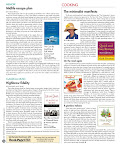Study: U.S. Territory Extends Farther Into Oil-Rich Region
After three years of expeditions to the Arctic, the National Oceanographic and Atmospheric Administration and the University of New Hampshire have made a discovery that is convenient for U.S. interests in an oil-starved world over-heated up by global warming.
The continental slope of Alaska, they say, extends 100 nautical miles farther under the Arctic Sea than previously thought. That means the U.S. can claim greater territory north of Alaska, should it ever get around to signing the U.N. Convention on the Law of the Sea. That 25-year-old international treaty allows signatories to claim territory based in part on the extent of the continental shelf.
“We found evidence that the foot of the slope was much farther out than we thought,” said Larry Mayer, expedition chief scientist and co-director of the Joint Hydrographic Center at UNH. “That was the big discovery.”
Russia, in its Arctic expeditions last year, during which seamen planted a titanium flag on the sea floor at the North Pole, claimed that its territorial claims were supported by new maps of the continental shelf. Three other countries also can claim territory in the Arctic.
The territory matters now more than ever, as the world's oil supply declines and global warming continues to melt the Arctic. Significant oil reserves are believed to be locked beneath the ice, but as the climate warms, they could become accessible. Last summer, Arctic sea ice retreated to the greatest extent ever recorded.
Coastal nations have sovereign rights over the natural resources of their continental shelf, generally recognized to extend 200 nautical miles out from the coast. The Law of the Sea Convention, now under consideration in the U.S. Senate, provides nations an internationally recognized basis to extend their sea floor resource rights beyond the foot of the continental slope if they meet certain geological criteria backed up by scientific data.
“We now have a better geologic picture of what’s happening in that area of the Arctic,” said NOAA Office of Coast Survey researcher Andy Armstrong, co-chief scientist on the expedition and NOAA co-director of the Joint Hydrographic Center. “These are valuable data for NOAA and the United States, and I’m pleased that we’re making them available for anyone to use.”
UNH/ NOAA
Above: A view of the Arctic sea floor.
UNH/ NOAA
Above: The Chukchi Borderland, a region of the Arctic sea floor north of Alaska.











0 comments:
Post a Comment